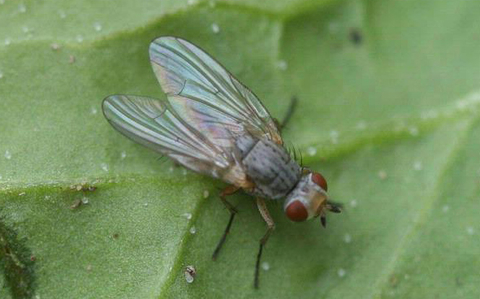Quick facts
- Leafminers burrow into leaves to feed, producing large patches or winding tunnels of dead tissue.
- The most common leafminers in Minnesota vegetable gardens are the spinach leafminer and the vegetable (serpentine) leafminer.
- Leafminers do not affect plant growth but can damage the edible leaves of vegetables.
- Plants can be protected through a combination of nonchemical methods and pesticides.
How to identify leafminers
Leafminer larvae and adults are rarely noticed. Seeing the insects doesn't mean you have a leafminer problem. Instead, watch for symptoms of leafminer feeding. Leafminers create patches or winding mines in vegetable leaves.
Spinach leafminers
The spinach leafminer (Pegomya hyoscyami) is a type of blotch leafminer, that creates irregular round-shaped mines. The mines are long and narrow at first but eventually become an irregularly shaped patch.
- The larvae are whitish and carrot-shaped and do not have legs or an obvious head.
- The adult fly is hairy, about 1/4 inch long, and grayish or brownish.
Vegetable leafminers
Vegetable leafminer larvae (Liromyza sativae) wind snake-like across the leaves and create winding mines.
- The larvae have yellowish-green and cylindrical-shaped bodies.
- They do not have legs or an obvious head.
- Vegetable leafminer flies are smaller than spinach leafminer flies (1/15 inch long) and are yellow and black.
Biology of leafminers
Both leafminer species have very similar life cycles.
- They survive the winter as pupae.
- Adult flies emerge the following April and May.
- The flies insert eggs into leaves.
- Larvae feed and develop within leaf tissue between leaf surfaces.
- Larvae are active for about two to three weeks.
- They drop to the ground next to the plants to transform into pupae.
- Several generations can develop in one year.
Damage caused by leafminers
The spinach leafminer feeds on:
- Spinach
- Swiss chard
- Tomato
- Cucumber
- Celery
The vegetable leafminer feeds on many plants including:
- Bean, pea
- Eggplant, pepper, potato, tomato
- Squash, watermelon, cucumber
- Beet, onion
- Lettuce
As the larvae feed and develop, they create “mines” of dead tissue where they have fed. These mines are opaque initially and then later turn brown.
Leafminer activity has little impact on plant growth but can be destructive to vegetables grown for edible greens.
How to protect your plants from leafminers
Check your plants regularly
Regularly check young seedlings for leaf damage, especially if leafminers have attacked your garden in the past. Most feeding occurs on the first true leaves.
Generally, vegetable leafminers are kept in control by their natural enemies and management is not required.
It is also not necessary to treat spinach leafminers when they are attacking the leaves of a root crop such as beets. But if it is on spinach or a leafy green, you may need to take action.
Keep your garden clean
- Remove weeds, like lambsquarter, to reduce their availability as a food source, for leafminers.
- Remove and destroy leaves when the damage is small.
- Till your garden after harvesting to destroy pupae and reduce the chances of adult flies moving to neighboring plants.
Use a physical barrier
- Use fine-meshed netting row covers to protect the plants from insects.
- Use material that does not prevent sunlight and rain from reaching the plants (like cheesecloth).
- Apply in areas where leafminer problems have not been seen for at least one year.
- If leafminer issues have been observed within the last year, this netting will not help because pupae that survived the winter are inside the row cover and can still infest plants.
Using pesticides
Using pesticides prevents adults from laying eggs but does not kill larvae that are already feeding within plant leaves. Choose a low-impact pesticide that does not target natural enemies (such as parasitic wasps) and pollinators (such as bees).
- Spinosad can be an effective option. It is derived from a naturally occurring soil-dwelling microorganism, provides good control, and has little impact on natural enemies.
- Broad spectrum pesticides (like permethrin, bifenthrin, and carbaryl) are generally longer lasting but can kill natural enemies too.
- You can apply pesticides in the spring when adult flies are first active.
- Make sure you get good coverage on the leaves.
- Make several treatments at regular intervals (check the label to determine how often you can apply a particular product).
CAUTION: Mention of a pesticide or use of a pesticide label is for educational purposes only. Always follow the pesticide label directions attached to the pesticide container you are using. Be sure that the plant you wish to treat is listed on the label of the pesticide you intend to use. And observe the number of days between pesticide application and when you can harvest your crop. Remember, the label is the law.
Reviewed in 2023





